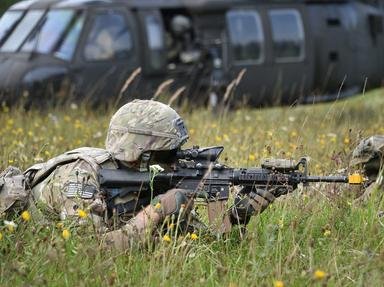Quiz Answer Key and Fun Facts
1. For 300 years, since the invention of firearms, the lead ball remained the only form of ammunition employed. This early design was limited in accuracy and range. Claude-Etienne Minie's invention of the Conical bullet or "Minie Ball" was a major leap in bullet design, overcoming the drawbacks of the lead ball.
What made this bullet design so much more effective than the lead ball?
2. Although mounted units have been employed since the earliest periods of human civilization, one item of equipment to optimize combat from atop a horse was developed relatively late. This innovation greatly improved a rider's stability, balance and ability to move the upper body while on horseback, leading to a significant improvement in the effectiveness of mounted archers and other cavalry troops.
What was this invention?
3. During his conquests in Europe, Napoleon Bonaparte developed the "Corps" as a new military structure for his army. The corps lent him great flexibility and the ability to quickly capitalize on opportunities. This structure has now become standard in modern militaries.
Which of these best describes a corps?
4. It is said that when these two ironclads met in combat on March 9th 1862 every other navy in the world became obsolete. These two American Civil War era ships marked the shift away from wooden warships and a period of significant change in naval warfare.
What were the names of these two ironclads (one Union ship and one Confederate ship)?
5. The Roman Legions are often referenced as a prime example of a professional and highly effective military force. However, they were not always so. Only after the Marian reforms enacted in 107 BC did Rome's armies start to become the legions we are most familiar with in film and story today.
Which one of these was NOT among Marian's reforms?
6. During Germany's air raids of Britain in WWII, one innovation was instrumental in Britain's successful defense against a superior air force. This allowed the British to effectively counter Germany's numerical advantage with only a limited number of planes. The targeted deployment of squadrons saved precious resources and countless lives.
What was this innovation?
7. The Janissary corps is often cited as being the first to adopt what are now standard military practices such as regular pay, soldiers quartered in barracks, uniforms and marching to music. These soldiers were counted among the most elite and organized forces of the day.
To which empire did the Janissary corps belong?
8. The quote "An army marches on its stomach" is as true today as it was centuries before. The limited ability of armies to provide a regular supply of adequate food meant that feeding an army on campaign was a major problem, especially so with larger armies traveling greater distances. Thus, the development of "canned" food was a significant step for all armies.
During which period was "canned" food first developed? (Canned food is not limited to metal-based containers)
Hint: The person who said the quote is from the same period.
9. The wearing of helmets by the basic infantryman went into decline during the 18th century. Only during the First World War did helmets reappear as standard equipment, the first being the French M15 credited to August-Louis Adrian. Adrian was trying to protect soldiers from a specific injury which is what spurred the development of the M15. What kind of protection was he looking for?
10. Archeological findings of Paleolithic humans have shown that the tools they employed had begun to evolve into more effective designs. One of these is called the Atlatl. Of very simple design, this tool greatly improved early man's hunting by taking advantage of some basic scientific principle. The strenghts of the Atlatl no doubt carried over to conflict between humans as well. Those armed with this tool certainly had a significant advantage over those who did not.
What best describes the Atlatl and what it did?
Source: Author
McAngus
This quiz was reviewed by FunTrivia editor
stedman before going online.
Any errors found in FunTrivia content are routinely corrected through our feedback system.

